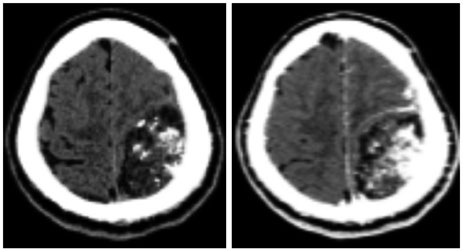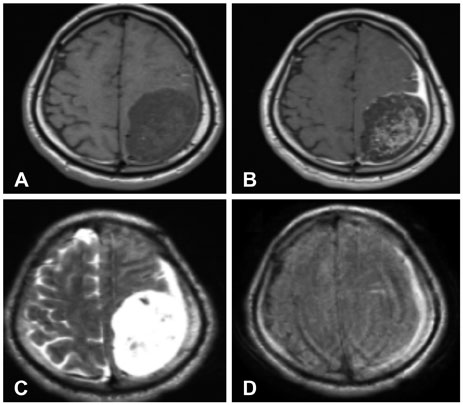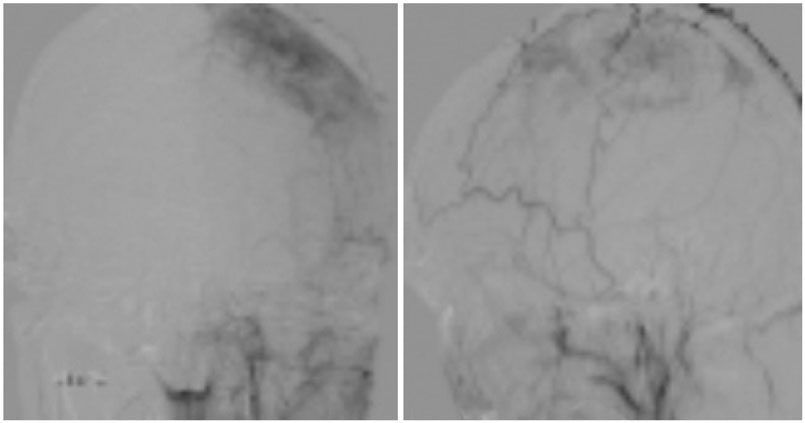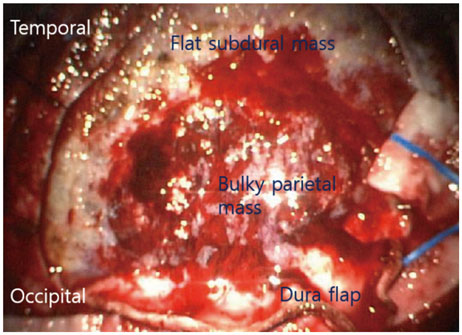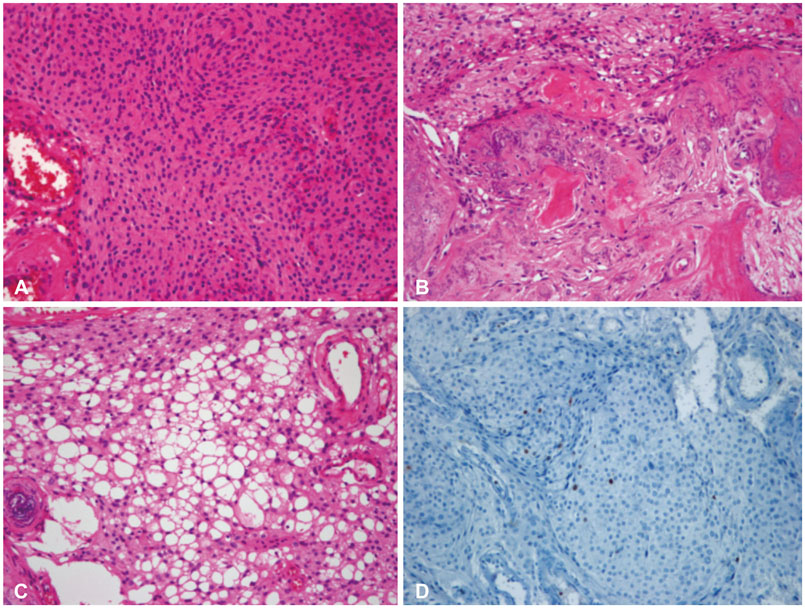Brain Tumor Res Treat.
2018 Oct;6(2):97-100. 10.14791/btrt.2018.6.e17.
Metaplastic Meningioma Overspreading the Cerebral Convexity
- Affiliations
-
- 1Department of Neurosurgery, Ilsan Paik Hospital, College of Medicine, Inje University, Goyang, Korea. cychoi@paik.ac.kr
- 2Department of Pathology, Ilsan Paik Hospital, College of Medicine, Inje University, Goyang, Korea.
- KMID: 2423982
- DOI: http://doi.org/10.14791/btrt.2018.6.e17
Abstract
- Meningioma is relatively common, benign, and extra-axial tumor accounting for about 20% of primary brain and spinal cord tumors. The World Health Organization (WHO) classified these tumors into Grade I (benign), Grade II (atypical), and Grade III (anaplastic) meningioma. Grade I meningioma which is slowly growing tumor and have some rare subtypes. Among them, metaplastic subtype is defined as a tumor containing focal or widespread mesenchymal components including osseous, cartilaginous, lipomatous, myxoid or xanthomatous tissue, singly or in combinations. We report a rare metaplastic meningioma overspreading nearly whole cerebral convexity from main extra-axial tumor bulk in the parietal lobe.
MeSH Terms
Figure
Cited by 1 articles
-
Intracranial Metaplastic Meningioma : Clinical and Radiological Characteristics of 11 Cases
Taehoon Kim, Jin Wook Kim, So Young Ji, Ho Kang, Kyung-Min Kim, Yong Hwy Kim, Chul-Kee Park, Seung Hong Choi, Sung-Hye Park
J Korean Neurosurg Soc. 2020;63(5):657-663. doi: 10.3340/jkns.2020.0151.
Reference
-
1. Perry A, Louis DN, Scheithauer BW, Budka H, von Deimling A. Meningiomas. In : Louis DN, Ohgaki H, Wiestler OD, Cavenee WK, editors. World Health Organization classification of tumours of the central nervous system. Lyon: IARC Press;2007. p. 164–172.2. Huang J, Petersson F. Intracerebral metaplastic meningioma with prominent ossification and extensive calcification. Rare Tumors. 2011; 3:e20.
Article3. Tang H, Sun H, Chen H, et al. Clinicopathological analysis of metaplastic meningioma: report of 15 cases in Huashan Hospital. Chin J Cancer Res. 2013; 25:112–118.4. Matyja E, Naganska E, Zabek M, Jagielski J. Meningioma with the unique coexistence of secretory and lipomatous components: a case report with immunohistochemical and ultrastructural study. Clin Neuropathol. 2005; 24:257–261.5. Johnson MD, Stevenson CB, Thompson RC, Atkinson J, Boyer P. December 2006: 31-year-old woman with hemiparesis. Brain Pathol. 2007; 17:255–257.
Article6. Majumdar K, Mandal S, Thakkar R, Saran RK, Srivastava AK. Meningeal osteochondroma simulating meningioma with metaplastic change: a rare golf-ball-like lesion of non-meningothelial mesenchymal origin. Brain Tumor Pathol. 2014; 31:62–67.
Article
- Full Text Links
- Actions
-
Cited
- CITED
-
- Close
- Share
- Similar articles
-
- Intracranial Metaplastic Meningioma : Clinical and Radiological Characteristics of 11 Cases
- Cerebral Arteriovenous Malformation Associated with Intracranial Meningioma and Aneurysm: Case Report
- Convexity Meningioma En Plaque Presenting with Diffuse Hyperostosis of the Skull
- Anaplastic Cystic Meningioma
- Totally Ossified Metaplastic Spinal Meningioma

